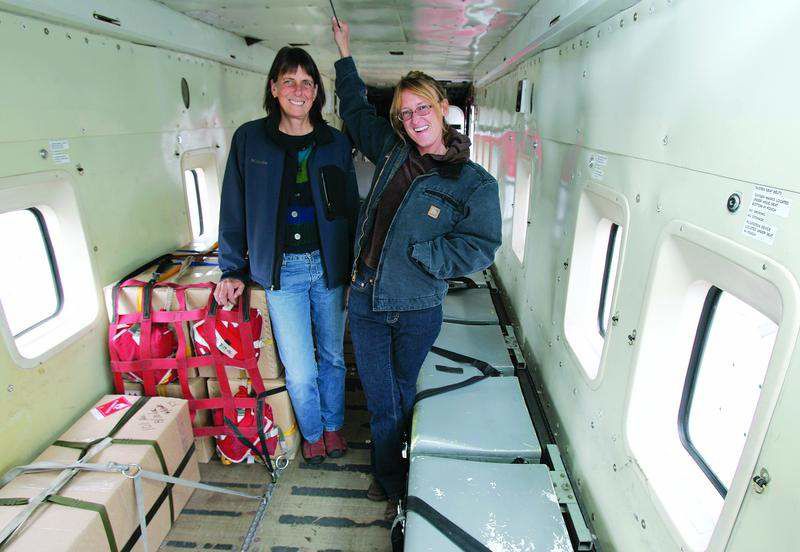A leap forward
Published 5:00 am Saturday, October 14, 2006

- Renee Lamoreaux, behind, and Kelly Esterbrook stand in one of the airplanes at the Redmond Air Center on Oct. 4.
n the corporate world, it’s called breaking through the glass ceiling when women get promoted to high-level jobs. For the first generation of women smoke jumpers in the U.S. Forest Service, it could be called literally breaking through the clouds.
”My whole career, it seems there were some people who said you can’t do it. I think they just didn’t have a picture in their mind of a woman doing this job,” said former Forest Service smoke jumper Kelly Esterbrook. ”Back then, there were no women squad leaders.”
Smoke jumpers are the elite crews of firefighters who parachute down into remote, rugged and often steep wild land fire areas, which are not easily accessible by foot or truck. The highly skilled and trained smoke jumpers are considered a national resource, and crews are sent throughout the Western states to battle forest fires.
Esterbrook, now 50 years old, first began her career as a Forest Service wild land firefighter, more commonly known as a ”hotshot,” in 1984.
As a hotshot, she was known as the ”sawyer,” the person who runs the saw on the fire line.
Renee Lamoreaux, 49, began her fire career in much the same way, starting on the hotshot crew as a sawyer, ”which was pretty unusual for a woman back then,” she explained.
It was even more unusual, and almost unheard of, when in 1986, Esterbrook decided she wanted to be a smoke jumper.
”I was told you don’t want this job … but the more someone says you can’t, the more you want it,” explained Esterbrook. ”I saw it as a challenge, and I have a streak of stubbornness.”
In 1989, Lamoreaux would join Esterbrook as part of the first generation of women smoke jumpers in the country. By their own estimation, they believe they were among the first 10 female smoke jumpers in the nation.
Earlier this month, both Lamoreaux and Esterbrook came back to their old stomping ground at the Redmond Air Base for some photos.
Climbing into one of the jump planes brought back a flood of memories.
”I do miss hanging out of the side of the plane,” said a nostalgic Lamoreaux.
The memories are a mixed bag, some good and some bad. But when asked if they’d do it all over again, both, without hesitation said, ”in a minute; once a smoke jumper, always a smoke jumper.”
Changing minds
The early years for women in this profession were rough. Just ask Deanne Shulman, who was the first female smoke jumper in the country. She broke into the all-male ranks in l981 after an uphill battle.
Two years earlier, Shulman had passed all the same rigorous physical tests as the other male smoke jumper candidates. It was only after she had completed her rookie training that she was told she couldn’t be a smoke jumper because she weighed 125 pounds, which at the time was five pounds under the 130-pound minimum.
Shulman was angry. Some smoke jumping colleagues at the time told Shulman there were two male smoke jumpers out of Missoula, Mont., who were also under the weight limit, and they had not been fired.
After much encouragement from other smoke jumpers, who saw how hard Shulman worked in rookie training camp, she filed an Equal Employment Opportunity complaint.
The minimum weight requirement was eventually lowered to 120 pounds, which opened the field to more women like Lamoreaux, who not only had to prove herself as a strong woman, but also had to overcome the stereotype people had of her because she was petite.
”I remember my first week, someone who I won’t mention sat me down and told me point blank, ‘You’re too small for this job,’” recalled Lamoreaux. ”I remember thinking, ‘You don’t even know me.’ So that was my challenge.”
Lamoreaux didn’t let her petite size get in the way; she proved she was every bit as strong and prepared for the job as anyone.
”We have worked hard to get here. There’s this whole entrance thing, the boot camp/rookie training, where you have to run a mile and half in 11 minutes, then do the push-ups and pull-ups. We have to bushwhack with an 85-pound pack on our back for seven miles. Then there’s the 110 pound pack out, for three miles and it’s timed,” explained Lamoreaux. ”And that’s just the first week. Later we practice parachute landings, falls, let downs, rappelling, exiting from an aircraft.”
Lamoreaux recalls a big ”wash out” period for both men and women was the tree-climbing test, where rookies must climb up a 120-foot tree and rappel down.
”A lot of attrition rate here, because a lot of people have fear of heights, but this is a necessary test,” said Lamoreaux. ”Some fires on the West side have old-growth forest, and those trees are really big. You have to carry let- down ropes that measure 250 feet.
”Normally, it’s only 150 feet of rope you have to carry in your pocket.”
Earning respect
Because the tests are exactly the same for both men and women in the smoke jumping crews, Esterbrook believes it did make it easier for women to be accepted into the mostly male-dominated firefighting crews.
”In some ways, it was easier to get acceptance, because they knew we all had to pass the same test,” said Esterbrook.
Lamoreaux shakes her head in acknowledgment. ”I do think we were accepted and respected for that.”
Nevertheless, Esterbrook admits she did feel a lot of pressure of having to constantly prove herself.
”For one year, I was the only woman jumper here, and I didn’t like it. The conversation is just different. Early on, I think some men felt threatened. I entered smoke jumping when affirmative action really came in, and some men felt I was taking their job. They also felt, or viewed it that I had an unfair advantage being a woman,” recalled Esterbrook. ”It was good to have the encouragement in general of other women who later came in the unit.”
That’s how Esterbrook and Lamoreaux first became close friends, though they readily admit all the smoke jumpers, whether male or female, have a special bond and camaraderie.
Still, Esterbrook recalls a conversation, and some advice she once received from her supervisor.
”He said to me, ‘There will be some men who will accept you, and then there will be some men who you can change their minds, and then there will be those who just can’t ever see you here,’” said Esterbrook. ”But I knew I could do the job.”
Above and beyond
Not only did Esterbrook and Lamoreaux prove themselves as smoke jumpers over the years, they also honed their skills and earned the trust of fellow smoke jumpers to be promoted as spotters: leaders of the smoke jumping crews.
”You have a spotter who directs the pilot. The spotter will drop streamers, which are a rolled up crepe paper, to gauge which way the wind is moving, and where the most advantageous and safe place for the crew to jump,” explained Esterbrook. ”This can be very stressful, because you’re responsible for your crew and that mission.”
Esterbrook jumped out of planes for the Forest Service for a decade, and Lamoreaux perfected her skills over a 16-year period, without a single injury.
However, both have had close calls.
”We were at a large fire in Colorado, and we had a planeload of jumpers, and being lighter (in weight), I just got sucked in towards the fire,” said Lamoreaux, gesturing with her hands as she tried to explain. ”I just remember trying to dump air, and spiraling down as fast as I could. I landed only about 10 feet from it.” Back then, Lamoreaux explains, there was only one size parachute for all smoke jumpers; today there are three different sizes to compensate for body weight.
Lamoreaux not only survived that near miss, she thrived, later winning the ”Jump Hog Award” presented to the smoke jumper with the most jumps in one summer. She jumped 21 times that summer.
When asked how her parents felt about her career choice, Esterbrook explains with a chuckle that her mother had her whole church praying for her. And then on a more serious note, Esterbrook says she does believe in guardian angels.
”We were going to a fire on the gorge and it was really windy. We had flown over Mount Hood late in the day and circled for an hour looking for a jump spot. Finally, I went down, and just as I was a few feet from landing on this knife ridge, a sudden ridge wind sailed me off the ground. A little tree snagged me, so I didn’t hit the boulders, but I was swinging like a pendulum. Right in front of me was another snag pointing this close to my chest; it was like a spear,” said Esterbrook, gesturing about an inch away from her heart. ”That made me believe you have a guardian angel, because I shouldn’t be here now.”
Breaking through the clouds
Bill Zelby, manager of the Forest Service’s smoke jumper program at the Redmond Air Base, credits both Esterbrook and Lamoreaux for breaking new ground for female smoke jumpers today.
”This summer, for new hires, we only hired women smoke jumpers for our crew. That’s never been done at any (smoke jumping) airbase in the country,” said Zelby. ”We probably had at least 200 applicants for those five spots, but these five women proved they were the best for the job.”
While the number of female smoke jumpers is growing, it is still a relatively small and elite number.
According to a Forest Service Web site (www.smokejumpers .com), there are about 400 smoke jumpers in the country, and only about 30 are women.
Esterbrook, who is now a Forest Service assistant fire manager at the Bend-Fort Rock Ranger District, says she attended a women’s smoke jumpers reunion in Sun Valley, Idaho, a few years ago, and the roster showed only 74 current and retired smoke jumper’s names, but she’s confident that number will continue to grow.
”I do look back at it as an accomplishment,” said Esterbrook. ”You can get ridiculed, and there’s no special treatment, but I proved I can do what I set my mind to do. It was against all odds. I did this for a career, but it is the best job in the Forest Service.”
After 16 years of smoke jumping, Lamoreaux decided to call it quits two years ago because she wanted to go out strong. Since then, she has been promoted to Forest Service fire prevention manager at the Bend-Fort Rock Ranger District.
”This summer, I was thinking I didn’t have much stress. I didn’t have to think: ‘Where are we going to be sent to jump?’ There was a time, all I had to do was watch the weather channel and follow the lightening to know which state we’d be going to,” said Lamoreaux, who still, like Esterbrook, follows the fires in Oregon, managing hotshot ground crews.
Zelby calls Lamoreaux and Esterbrook the true Oregon trailblazing women of the industry.
”It was different in those early years for them; they really had to get past the mind-set,” said Zelby as he watched the former smoke jumpers get in the jump plane. ”They were definitely pioneers for the time.”






